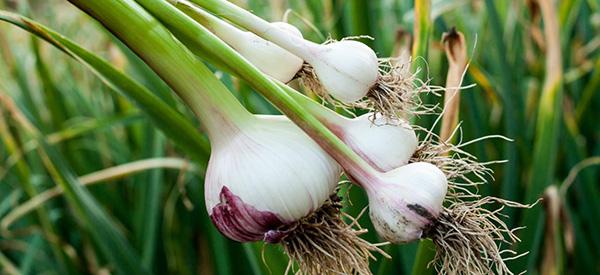
Garlic
Garlic (Allium sativum) is one of the species in the onion, or allium, genus. It is closely related, therefore, to onions, chives, shallots, and leeks. All of these are flowering plants that are grown for their bulbs.
This plant is a perennial but is now primarily grown domestically and commercially as an annual. It has been cultivated for so many centuries that many varieties no longer produce flowers or seeds, and propagation is now using the bulbs or the individual cloves within them.
While Garlic has been used in both cooking and traditional medicine for thousands of years, its popularity has grown. There are now at least 120 cultivars available.
The history of Garlic
Garlic has been with us for thousands of years, both as an ingredient in foods and as traditional medicine. Cuneiform records of the use of garlic in Mesopotamia date back 4,000 years, well-preserved remains were found in Tutankhamun’s tomb, and it was used in Ancient China and Greece for almost as long.
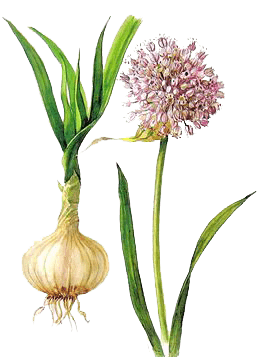 According to the Ancient Roman, Pliny the Elder, this plant was also eaten in Africa. It is widely found and used in Mediterranean Europe but, despite it being cultivated there since the early 16th century, it was not used in English cooking.
According to the Ancient Roman, Pliny the Elder, this plant was also eaten in Africa. It is widely found and used in Mediterranean Europe but, despite it being cultivated there since the early 16th century, it was not used in English cooking.
The Ancient Egyptians, Chinese, Japanese, Romans, and Greeks all used it in medicines and traditional remedies. It was used as a general cure-all in Greece, to treat bites, arthritis, internal parasites, and coughs in Persia, and in England to treat sunburn, smallpox, and edema. The plant was considered an aphrodisiac and generally therapeutic in India. Elsewhere in the East garlic was used to combat a diverse range of conditions.
Where this plant is found
The most common Garlic type is believed to be native to Central Asia and northeastern Iran. It has subsequently become naturalized and is extensively grown commercially, by individuals, and is still found growing wild.
The Spanish, French, and Portuguese introduced garlic to the New World. Various species and cultivars are now found in the Middle East, the Far East, the Baltic states, the US, various European countries, northern and southern Africa, India, Cuba, Mexico, Jamaica, Trinidad-Tobago, and Seychelles.
Related: The Complete Map of Edible Plants: Find Out What You Have in Your Area! (Video)
How to identify Garlic
Allium sativum, of which there are two subspecies, has stems that grow to a height of up to 3 feet / 1 meter. The most distinctive feature is the root or bulb.
- Stem: The stem or stalk is tall, erect, and fleshy. The flowers form on the end of the flower stalks.
- Leaf: The leaf is light green, flat, long, and narrow, and ends in a sharp point. They emerge from and wrap-around, the stalk.
- Flower: The flowers are hermaphrodite (i.e., they have both male and female organs). The form in an umbel or cluster and ranges in color from white to pink to red or green.
- Bulb: The bulb is edible and consists of 10 to 20 separate cloves each of which is covered in a thin outer sheath. The cloves are pungent, fleshy, and asymmetrical.

Left to right: leaves, flowers, and a bulb with cloves
It is the bulb that is the most utilized part of the plant and the reason why the plant is grown, although some gardeners find to use them as additions to flower beds.
Click Here to Learn More About How to Correctly Identify Over 400 Wild Plants (Video)
How to Grow Garlic
Garlic is propagated from the bulbs or, more accurately, from cloves including ones you buy from the store. The reason is that the garlic we grow has lost its ability to produce fertile seeds. In fact, some plants don’t even produce flowers.
In terms of growing conditions, Garlic plants:
- Need full sun
- Require well-drained soil rich in organic matter
- Will tolerate sandy soils if they are given extra water and feeding.
Prepare the soil beforehand by loosening it and digging in compost or well-rotted organic matter and nitrogen fertilizer. Bulbs should be planted in late summer or fall as most varieties require cold. The cold helps the roots to develop and the shoots to emerge.
Planting garlic is easy:
- Separate the bulb into cloves

- Select the largest ones for planting
- Plant the clove pointed side up at a depth of 2 – 3 inches / 5 – 7 ½ centimeters
- Place the cloves about 6 inches / 15 centimeters apart
- Mulch with 3 – 4 inches / 7 ½ – 10 centimeters of straw or horticultural fleece to protect the cloves from damage
- Remove the mulch in spring
- Keep the soil moist but not soggy as the cloves will rot before developing fully. Mulching materials such as sawdust should be avoided as the soil will be too wet.
In terms of ongoing care:
- Once the young plants have reached a height of 6 inches / 15 centimeters you can use a mulch to help suppress weed growth
- Use a nitrogen fertilizer when the plants reach a height of 4 – 6 inches / 10 – 15 centimeters
 Remove all weeds as garlic plants will have to compete for moisture and nutrients
Remove all weeds as garlic plants will have to compete for moisture and nutrients- The roots are shallow, so you need to water the plants if there is no rain. Lack of water results in yellowing leaves and small bulbs
- Avoid overwatering (the leaves will wither as an indication) as the bulbs will become diseased or stained.
Garlic is hardy and resistant to most pests and diseases. Certain animals avoid it in fact because of the pungent smell and strong taste. However, watch out for any sign of disease and deal with it appropriately.
How to harvest and store this plant
You can harvest garlic in two forms:
- Scapes: These are the young, tender stems that are harvested in early summer when the stems are still curled and have not thickened and straightened or formed flower buds. They can be eaten whole or chopped and raw or cooked. They have a mild flavor.
- Bulbs: Use a spade or gardening fork to lift the bulbs and remove the plant with the stalks attached.
- Immature bulbs: These are milder than their older counterparts and can be lifted when you harvest scapes.

- Mature bulbs: The older the bulb, the punchier the flavor.
The 10 Medicinal Seeds You Should Plant for a Complete Backyard Pharmacy (Video)
You will know it’s time to harvest when about half the leaves have turned brown. You can always dig up a couple of bulbs to assess size first if you are unsure.
To process and store garlic, carefully knock off the soil around the roots and bulb. Don’t wash them as they may develop mold or fungus.
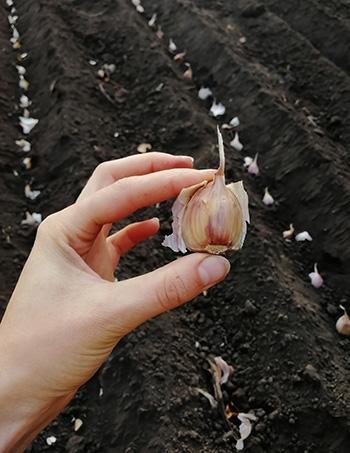
You can either leave the full stalk attached or cut them off 3 – 4 inches / 7 ½ – 10 centimeters above the bulb but always leave the bulbs intact. Lay the plant material out on a suitable surface (mesh or a rack) or tie the stalks in bunches and hang them up. In either case, the area must be cool and well-ventilated to facilitate drying.
Drying should take 2 – 4 weeks depending on conditions. You will know the process is complete when the roots feel brittle and can be rubbed off easily along with any remaining soil.
Cut the stalks off ½ – 1 inch / 1 ¼ – 2 ½ centimeters above the bulb and trim off all the roots at the base of the bulb. Brush the bulbs clean and remove the outermost skin. Keep the bulbs whole and they will keep far better than loose cloves.
Softneck varieties will keep at room temperature for up to 8 months. Hardneck garlic stored at room temperature will keep well for up to 4 months. To extend this shelf life to 7 months, store them in a cold place (at about 32 Fahrenheit / 0 Celsius). If bulbs get too warm, they will sprout. Bulbs you want to use for planting should be kept at room temperature.
What Garlic is good for & the natural remedies made from it
Garlic contains a range of active ingredients including a range of sulfur-containing compounds, enzymes, saponins, and flavonoids. In addition, garlic contains:
- Calcium
- Choline

- Iron
- Magnesium
- Manganese
- Phosphorous
- Potassium
- Selenium
- Sodium
- Vitamins B-1, B-2, B-3, B-5, B-6, B-9, and C
There has been some study of the effects and benefits of consuming garlic. However, much of the evidence remains anecdotal and there is either no or no conclusive evidence for some claims. The following are either historic uses or have been shown in studies to be valid:
- Boost the immune system
- Lower blood pressure

- Reduce cholesterol levels
- Prevent certain conditions due to antioxidant properties
- Boost athletic performance
- Detoxify the body
- Strengthen bones
- Reduce the risk of some cancers
- Ease osteoarthritis
- Combat Campylobacter bacterium in the gut
- Strengthen the heart
- Ease the symptoms of the common cold
- Reduce inflammation.
Again, it is important to note that not all of these are supported by clinical studies. In addition, raw garlic has been found to be more potent or effective than heated/cooked garlic. However, eating raw garlic is not something many people want to do. It is worth keeping in mind that eating fresh parsley can help reduce garlic breath.
Related: Add This “Unusual Nutrient” to Coffee or Tea, to Effortlessly and Fully Empty Your Bowels Every Single Morning (Video)
What parts of the plant are used in remedies?
It is the bulb and cloves that are used to produce oils, extracts, extract powder, and in DIY remedies.
A DIY Garlic recipe
One way to ingest garlic that is both palatable and won’t make you too pungent is by drinking Garlic Tea.
Ingredients
- 3 cloves of garlic
- 3 cups of water
- ½ cup of fresh lemon juice
- ½ cup of honey (optional)
Method
- Peel and cut the cloves in half for a strong flavor. Leave them whole and unpeeled for a weaker flavor

- Place the garlic and water in a saucepan and bring to the boil

- Remove from the heat, measure the lemon juice and add it (and the honey)

- Leave the liquid to cool
- Pour ½ cup and sip it slowly and refrigerate the rest.

You may expect this to taste unpleasant at best but give it a chance; it may surprise you.
Dosage
There are several garlic remedies now on the market. The composition of each varies depending on how it was produced and what it is designed for. Because of the lack of (a) clinical dose guidelines and (b) manufacturing standards, you must be guided by the instructions from the manufacturer and/or your healthcare provider.
Related: 1 Cup Before Bed Shrinks Belly Fat All Night (Video)
What plants resemble Garlic?
It can be helpful to distinguish between garlic varieties: hardneck and softneck.
In addition, there is a plant with the common name Elephant Garlic that is not garlic at all but a leek. All are edible but it can be useful to be able to differentiate. This table should help you to do so:
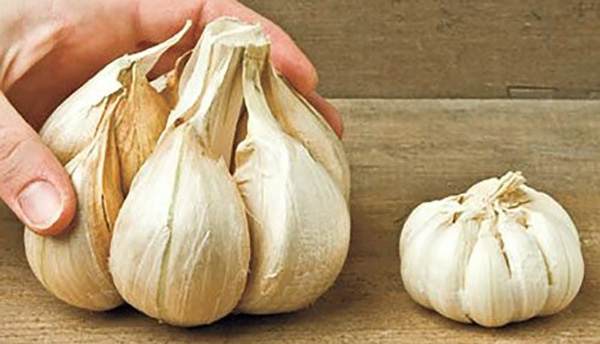
| Feature | Hardneck Garlics Allium sativum var. ophioscorodon | Softneck Garlics Allium sativum var. sativum | Elephant Garlic Allium ampeloprasum |
| Varieties | Porcelain, Rocambole, and Purple Stripe | Artichoke and Silverskin | Not applicable |
| Stalks | Coiled, woody, scape/flower stalk; bulbs smaller if flower stalks not removed | Coiled, woody, scape/flower stalk | Tall, solid, fleshy stalks |
| Leaves | Porcelain: pale to deep green leaves Rocambole: dark green or blue-green leaves Purple Stripe: deep green | Artichoke: slightly pale green leaves Silverskin: pale green leaves | Large blue-green strap-like leaves with a central rib |
| Bulbs | Porcelain: satiny white bulbs; 4-6 large cloves; hard to peel Rocambole: off-white bulbs with a purple blush; 6-11 plump, easy-to-peel cloves Purple Stripe: bright purple streaks and blotches on both bulb and cloves; 8-12 cloves. | Artichoke: 4-12 milk white cloves in a single circle around the central stalk; hard to peel Silverskin: white or pink blushed bulbs; 8-12 or 18-24 cloves; hard to peel; 2 layers of cloves | Extremely large; 5 – 6 cloves surrounded by smaller bulblets; milk-white outer skin; pale brown and white streaked cloves |
| Flavor | Porcelain and Rocambole: mild flavor after harvest but intensifies during storage Purple Stripe: very flavorful | Artichoke: very mild flavor Silverskin: strong, hot flavor | Very mild garlic flavor but may have a slightly bitter taste |
Which garlic variety you select may depend on where you are and what you can grow or buy, what you want to use the garlic for, and which flavor you enjoy most. some people opt for Elephant Garlic because of the flavor and clove size.
Warning And cautions
It won’t come as a surprise to many that the most common adverse effects of ingesting garlic are problems with body and breath odor. Interestingly, sipping milk while eating garlic significantly reduces ‘garlic breath’. Drinking milk afterward is not as effective. Using plain water or eating basil leaves or mushrooms may also neutralize this problem slightly.
In addition, some individuals may also experience more unpleasant effects such as heartburn, bloating, belching, flatulence, nausea, vomiting, gastric pain, and constipation or diarrhea. Serious effects have been linked to uncontrolled bleeding in postoperative patients who are taking garlic supplements.
Also, some people are allergic to garlic and may experience mouth and throat ulcers, gastric upset, and – in the worst cases – breathing difficulties. Those who have an allergy to onions, chives, leeks, ginger, shallots, and bananas will most likely react badly to garlic.
The external application of garlic-based preparations has caused skin irritation, rashes, and – in some cases – burning and blistering.
As with all similar remedies or foods, if you have any doubts or concerns, speak to your healthcare provider first. This is especially true for individuals with diagnosed conditions and who are on medication.
You may also like:
Homemade Fermented Honey Garlic
10 Plants That You Should Never Plant Together (Video)
How To Prepare Medicinal Pickled Garlic
How to Make an Immunity Boosting Shot with Celery, Spinach, Ginger, Lemon, and Manuka Honey
7 Natural Remedies To Reduce Blood Clots And The Risk Of Stroke

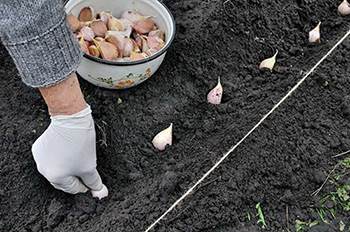
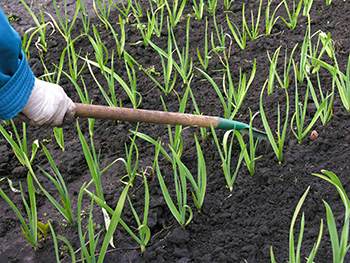 Remove all weeds as garlic plants will have to compete for moisture and nutrients
Remove all weeds as garlic plants will have to compete for moisture and nutrients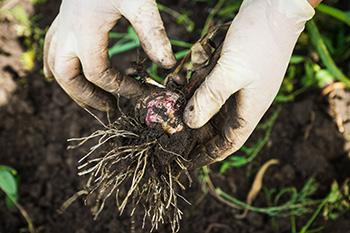
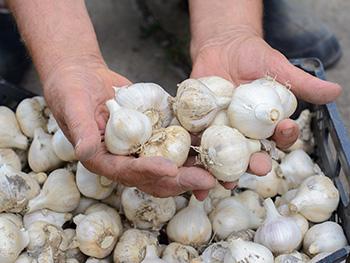
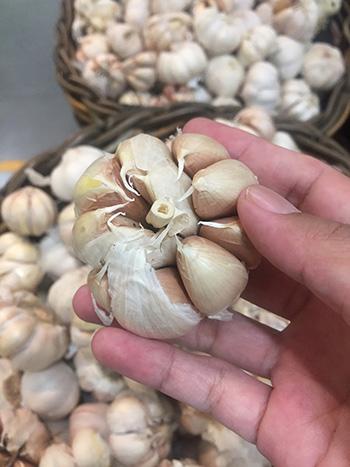
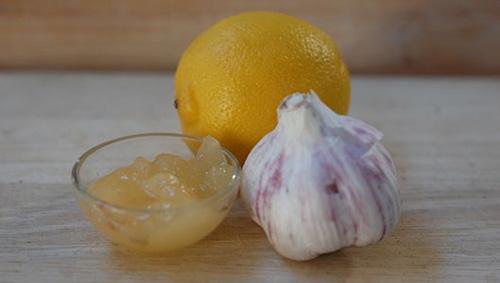
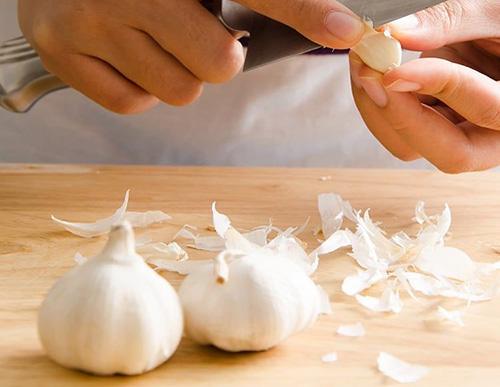
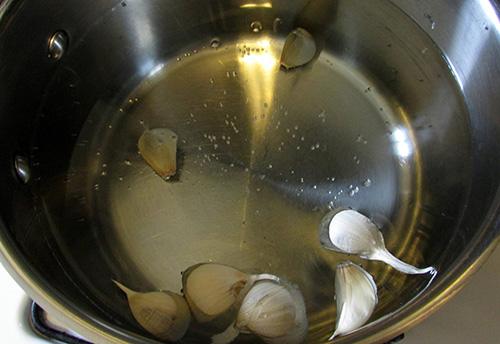
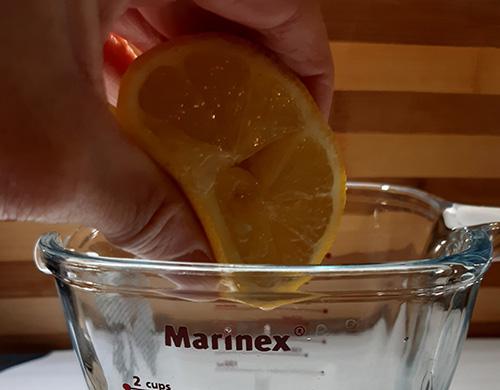
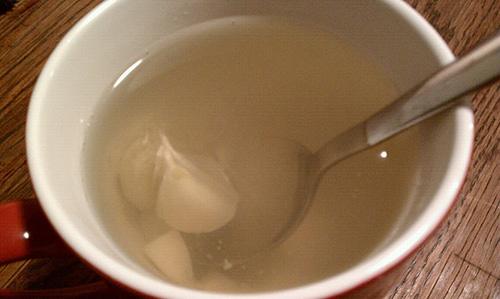
wow Interesting, love the information.
Imported garlic will not sprout as the USG requires it be irradiated upon entry. To tell, cut a clove near the top and look for a green center (if good). Irradiated garlic cannot produce allium as this is instantly produced by live cloves to fend off insect attack. No allium, no reason to consume it. Cooked garlic also loses this compound, so, crush and consume within 20 minutes for best effect. Fermented (black) garlic preserves allium and that which comes from China is still good. Also, I use every part of fresh plants, especially chives and ramps, in salads and I have known CIA trained chefs that throw away the white parts of chives. Who told them to do that?
Hi John R. Thank you for posting this about irradiation and the allium content. Grief! I know that the irradiation is bad, but not this bad. I see that potatoes are affected badly too. No more eyes growing in the back of the potato bin means no life in the potato, I’m convinced. I’ll bet the same is true for other irradiated “fresh” fruits and veggies. Thank you for your other notes, too.
Such a great source of info, thank you so much for your work
In New Zealand, imported garlic has no roots attached as they are removed for biosecurity reasons. Local garlic does have roots still attached, so if there are no roots, I won’t buy it. imported garlic is also very light.